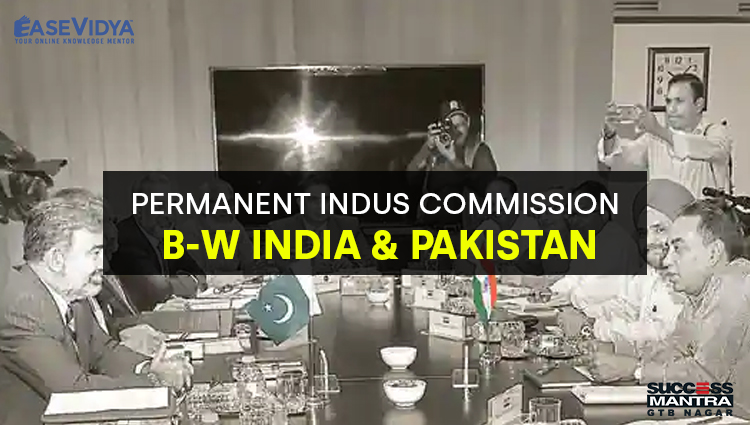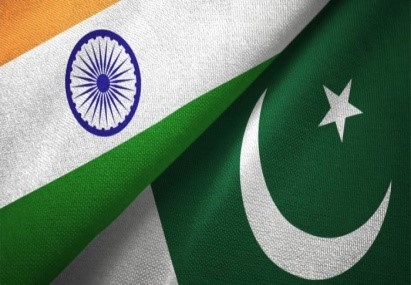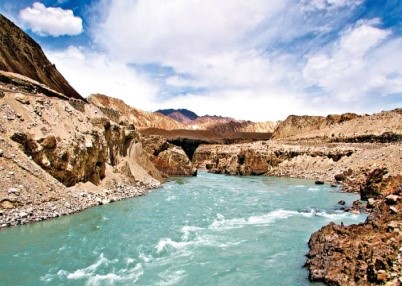
PERMANENT INDUS COMMISSION BETWEEN INDIA AND PAKISTAN
PERMANENT INDUS COMMISSION B/W INDIA & PAKISTAN
The 116th Meeting of Permanent Indus Commission (PIC) between India and Pakistan is underway in New Delhi. The first day of the Meeting coincided with the National Day of Pakistan (marks Lahore Resolution of 23rd March, 1940).
ABOUT THE LATEST MEETING B/W INDIA & PAK

The meeting is being held after a gap of more than two-and-a-half years, a period that witnessed: Pulwama attack (14th February, 2019), Balakot air strike (26th february, 2019), and Abrogation of special provisions under Article 370 that gave special status to J&K. A discussion on Pakistan’s objections about two India Projects - Pakal Dul and Lower Kalnai - is expected to be held. India is building Pakal Dul Hydro Electric Project (1,000 MW) on river Marusudar, a tributary of the Chenab. The project is located in Kishtwar district of J&K. The second project – Lower Kalnai – is being developed on the Chenab. Routine issues such as flood data exchange mechanisms are also expected to be discussed. The meeting is being seen as a positive step after both countries agreed to “strict observance of all agreements, understanding and ceasefire along the Line of Control and all other sectors” last month.
ABOUT THE PERMANENT INDUS COMMISSION
It is a bilateral commission of officials from India and Pakistan, created to implement and manage goals of the Indus Waters Treaty, 1960. The Commission, according to the treaty, shall meet regularly at least once a year, alternately in India and Pakistan.
The functions of the Commission include: To study and report to the two Governments on any problem relating to the development on the waters of the rivers. To solve disputes arising over water sharing. To arrange technical visits to projects’ sites and critical river head works. To undertake, once in every five years, a general tour of inspection of the Rivers for ascertaining the facts. To take necessary steps for the implementation of the provisions of the treaty. The 115th meeting of the PIC was held in Lahore in August, 2018.
INDUS WATER TREATY, 1960

It is a treaty brokered by the World Bank and signed by then Prime Minister Jawaharlal Nehru and Pakistan’s President Ayub Khan which administers how the waters of the Indus and its tributaries that flow in both the countries will be utilised. According to the treaty, waters of the eastern rivers — Sutlej, Beas and Ravi had been allocated to India, while the western rivers — the Indus, Jhelum and Chenab to Pakistan. Under the treaty, India has been given the right to generate hydroelectricity through a run of the river projects on the western rivers subject to specific criteria for design and operation. India has cleared several hydropower projects in Ladakh: Darbuk Shyok (19 MW), Shankoo (18.5 MW), Nimu Chilling (24 MW), Rongdo (12 MW), Ratan Nag (10.5 MW) for Leh; and Mangdum Sangra (19 MW), Kargil Hunderman (25 MW) and Tamasha (12 MW) for Kargil. It also gives Pakistan the right to raise concerns on the design of Indian hydroelectric projects on western rivers. The Treaty also provides an arbitration mechanism to solve disputes amicably. There have been disagreements and differences between India and Pakistan over dams. For eg. In 2010, Pakistan instituted international arbitration proceedings over India’s 330-megawatt hydropower project on a small Indus tributary, the Kishenganga (known as Neelum in Pakistan). Though Indus originates from Tibet, China has been kept out of the Treaty. If China decides to stop or change the flow of the river, it will affect both India and Pakistan. Climate change is causing melting of ice in Tibetan plateau, which scientists believe will affect the river in future.
LAHORE RESOLUTION: A HISTORIC SESSION
A historic session of the All-India Muslim League was held at Lahore in March 1940. Muhammad Ali Jinnah explained how Hindus and Muslims cannot co-exist peacefully. On 23rd March, an epoch-making resolution was moved at that session demanding that areas of the subcontinent of India in which the Muslims were numerically in a majority, as in the North-Western and Eastern Zones, should be grouped to constitute independent States. Having regard to the place of its adoption, the resolution was originally referred to as the Lahore Resolution. The Hindu Press, however, dubbed it as the Pakistan Resolution and eventually, in popular parlance, it came to be called as such. The Lahore Resolution was the beginning of the end of the administrative unity of the entire sub continent, which had been created by the Muslim Emperors and continued by the British; within eight years of its adoption the subcontinent was partitioned and Pakistan appeared as an independent sovereign State on its map.
TEST YOURSELF
Q.1 The 116th Meeting of Permanent Indus Commission (PIC) between India and Pakistan which started on 23rd March coincided with which of the following?
- National Constitution Day of Pakistan
- National Day of Pakistan which marks the date of Lahore Resolution: ANSWER
- The signing date of Indus Water Treaty
- None of the above
Q.2 Which of the following two Indian Hydro-electric projects has been objected by Pakistan which has been discussed in the meeting?
- Pakal Dul Hydro Electric Project
- Baira-Siul Hydroelectric Power plant
- Lower Kalnai Hydro Electric Project
- I & II follows
- II & III follows
- I & III follows: ANSWER
- None of the above
Q.3 Indus Water Treaty which is a treaty brokered by the World Bank and signed by which of the following Indian Prime Ministers?
- Jawaharlal Nehru: ANSWER
- Lal Bahadur Shastri
- Indira Gandhi
- Atal Bihari Vajpayee
Q.4 According to the Indus Water Treaty between India and Pakistan which of the following rivers had been allocated to Pakistan?
- Indus, Beas, Ravi
- Sutlej, Beas and Ravi
- Jhelum, Chenab, Ravi
- Indus, Jhelum and Chenab: ANSWER
Q.5 Which of the following statements is/are correct in the context of the above mentioned Passage?
- The Indus Water Treaty allows India to use 50% of the water of the Indus river, which flows through it first, for irrigation, power generation and transport.
- The water of Indus River is a lifeline of Pakistan and is a source of irrigation, hydro power and drinking water for millions of Pakistani citizens.
- Only I follows
- Only II follows: ANSWER
- Both I and II are correct
- None of the above












0 Comment